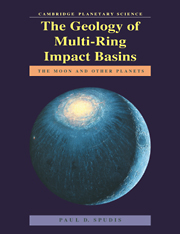Book contents
- Frontmatter
- Contents
- Preface
- 1 The multi-ring basin problem
- 2 From crater to basin
- 3 The ‘archetype’ basin: Orientale
- 4 An ancient basin: Nectaris
- 5 A modified basin: Crisium
- 6 A transitional basin: Serenitatis
- 7 The largest basin: Imbrium
- 8 Geological processes in the formation of lunar basins
- 9 Multi-ring basins on the terrestrial planets
- 10 Multi-ring basins and planetary evolution
- References
- Index
9 - Multi-ring basins on the terrestrial planets
Published online by Cambridge University Press: 12 October 2009
- Frontmatter
- Contents
- Preface
- 1 The multi-ring basin problem
- 2 From crater to basin
- 3 The ‘archetype’ basin: Orientale
- 4 An ancient basin: Nectaris
- 5 A modified basin: Crisium
- 6 A transitional basin: Serenitatis
- 7 The largest basin: Imbrium
- 8 Geological processes in the formation of lunar basins
- 9 Multi-ring basins on the terrestrial planets
- 10 Multi-ring basins and planetary evolution
- References
- Index
Summary
The formation of multi-ring basins was an important process in the early histories of Solar System bodies. Thus, study of basins on the other planets potentially can give us insight into the early geological evolution of the planets. Although occurring on all of the terrestrial planets, the most and best preserved basins occur on planets that display remnants of their early crusts, i.e., Mercury, Mars, and the icy satellites of Jupiter and Saturn. In this chapter, I discuss the geology of basins found on the terrestrial planets in relation to the geological model for basin formation and development on the Moon discussed above.
Earth
Most of the recognized impact structures on the Earth are either simple, bowlshaped craters or complex craters displaying central peaks (Grieve and Robertson, 1979; Masaitis et al., 1980; Grieve, 1987). However, several of Earth's larger craters have multiple rings; seventeen craters display at least two rings (Table 9.1; Pike, 1985 and references therein). The paucity of terrestrial multi-ring basins doubtless reflects the relatively youthful average surface age of the Earth, as compared with the more primitive terrestrial planets, such as Mercury and Mars.
Impact craters of the Earth show the morphological transitions with increasing size, as do craters on the planets, but changes in form occur at different diameters (Pike, 1985). Complex craters on the Earth range in size from about 4 km to about 25 km in diameter.
- Type
- Chapter
- Information
- The Geology of Multi-Ring Impact BasinsThe Moon and Other Planets, pp. 191 - 223Publisher: Cambridge University PressPrint publication year: 1993



